It is important to insulate the house not only on the enclosing structures, that is, on the walls, roof and foundation. Interfloor floors should also be insulated, moreover, not to reduce the heat loss of the building as a whole, but to localize the heat inside the building itself. If the house has two or more floors and each has heated rooms, but there are no barriers to the passage of heat through the ceilings, then the upper rooms will be the hottest. Thermal insulation of interfloor floors using wooden beams can effectively divide rooms to maintain an optimal microclimate, suppress heat convection throughout the building, and average the temperature distribution.
The choice of insulation
It is necessary to determine not only the insulation material that will be laid between the floor beams. It is important to decide on the whole complex of insulation, which will contain a number of materials and layers.
The main idea of \u200b\u200bwarming interfloor floors is to localize heat energy separately on each floor. Ideally, the bottom layer of the floor should be a heat reflecting shield capable of reversing most of the radiant energy.
Insulation is laid between beams and joists, without taking up extra space, without increasing the height of the floor. In view of the absence of a significant temperature difference, there is no need to talk about the minimum required layer thickness, the material is laid at the level of the beams and lag. Or a little less by 3-4 cm, to form a ventilation gap. The table shows the optimal insulation thickness depending on the thermal conductivity of the material:
The soundproofing properties of the insulation come to the fore. It is important to achieve good sound absorption, especially of the shock type.
It is not advisable to use foam for this. It conducts sound quite well by itself. Considering that it will be laid between the beams, the expanded polystyrene will work like a membrane, transmitting sound waves with almost no power loss.
It will be more relevant to use mineral wool, for example Rockwool with an increased sound absorption coefficient or an available analogue.
Much also depends on the design of the floor.
In the simplest case, insulation is laid between the floor beams, from below the beams are hemmed with sheet material or a board, logs and a rough floor of boards are laid on top, on top of which immediately goes flooring... In this case, it is better to choose mineral wool for insulation and lay it on top of a heat-reflecting vapor barrier.

Mineral wool is one of the best materials for insulation
Otherwise, on top of the subfloor, additional layer insulation made of dense slabs of mineral wool or extruded polystyrene foam, which acts as a damping layer. Chipboard and fine flooring are laid on top.
The use of bulk materials for insulation of interfloor floors is not justified. Mandatory presence of ventilation gaps with access to the inside of the room top floor increases the risk of fine suspension, dust from the insulation getting into the air. Sound insulating properties are also not high. The latter also applies to expanded clay.
Indoor use of polyurethane foam is not recommended due to its unsafe nature. Guarantee low level toxicity and exclude the possibility of polymer degradation is completely impossible.
Insulation technology
It is assumed that there is already a floor of wooden beams and nothing else, respectively, it is possible to insulate the floor, starting gradually from the bottom up. Moreover, the insulation will be double with a damper layer over the subfloor.
Tools:
- screwdriver;
- hacksaw, jigsaw;
- construction knife with replaceable blades;
- building corner;
- a hammer;
- scissors.
Materials:
- vapor barrier with a heat-reflecting screen;
- timber 40x30 mm;
- edged board 20 mm;
- floor board 30-40 mm;
- MDF 22 mm;
- mineral wool 50 (100) mm with high sound absorption coefficient;
mineral plate 50 mm;
- sunbond, geotextile;
- damper tape;
- self-tapping screws 75 mm;
- stapler and staples 14-16 mm;
- metallized scotch tape.
Work order:
- On the lower edge of the beams, cranial bars 40x30 are fixed using self-tapping screws 75 mm, every 50 cm.
- On top of the beams, a wooden reel is laid from a board 20 mm thick, laid across the beams with an emphasis on the cranial beams. It is important to leave a gap of approximately 10 mm between the edge of the board and the beam on each side.
- From below, the overlap is hemmed with a vapor barrier and a downward-directed heat shield. It can be one material of foil or foamed polyethylene covered with aluminum foil. All joints are glued with metallized tape.
- Mineral wool 50-100 mm thick is laid on top of the roll, depending on the required insulation.
- The insulation layer is closed with a vapor-permeable membrane, spunbond or geotextile. Its task is to prevent mineral wool fibers from entering the building through the underground ventilation. Fastening is carried out over the beams with fixation directly along the border of the laid insulation with the help of clips and a construction stapler.
- Logs are laid on the beams under the subfloor or immediately the floorboard, if the thickness of the ventilation gap above the insulation along the beams is 30-40 mm.
- The next layer is a dense slab of mineral wool or EPS, laid end-to-end over the entire floor area. A 10-15 mm gap from the walls is left along the perimeter or a damper tape made of expanded polyethylene is laid.
- A layer of insulation is closed with sheets of MDF (OSB) 22 mm thick.
- Be sure to form ventilation openings in the corners, closed with grilles for ventilation of the underfloor space. It is allowed to install ventilation ducts with their inclusion in the general ventilation system of the house, which will allow more efficient removal of steam and moisture from the floors.
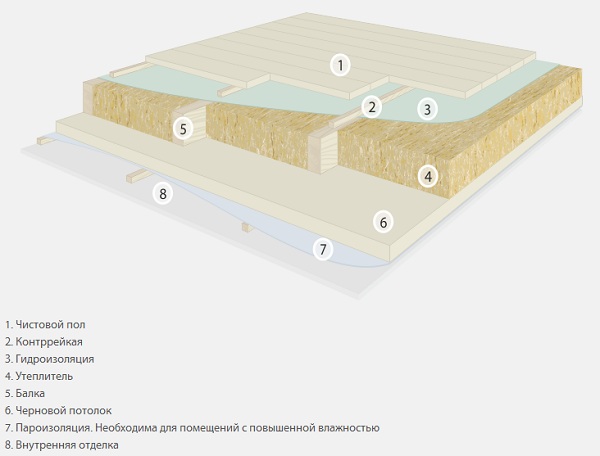
Insulation scheme
All that remains is to assemble the flooring. The skirting board is attached either to the floor or to the wall, covering the gap or damper tape. However, it is unacceptable to fix it to the wall and the floor at the same time.
From below, the ceiling is hemmed with a heat-reflecting screen and vapor barrier. Further, a suspended ceiling or filing with plasterboard or MDF sheets can be attached with further finishing of the final ceiling.
If the subfloor has already been laid, the work order is changed and the work is carried out from the side of the lower floor. First, the beams and niches between them are hemmed with spunbond. After that the cranial bars are attached, insulation is laid and fixed with wire. The niches with insulation are closed with a roll of boards, the ceiling is hemmed with a vapor barrier with a heat-reflecting screen. And then the final ceiling is mounted.
It is known that a wooden house is considered the standard of environmental friendliness and by itself has excellent thermal insulation performance. Despite this, many are thinking about additional insulation.
Such measures will significantly reduce heating and air conditioning costs. So the need for such events is visible to the naked eye.
The need for insulation
Floor insulation work progress
On this moment there are several technologies for floor insulation in wooden house... The most common and demanded is the option of a double floor, held on load-bearing logs. This is due to its ease of installation, so you can handle the work yourself. Also in this case, the use of any type of insulation is allowed, because there are no mechanical loads on it. 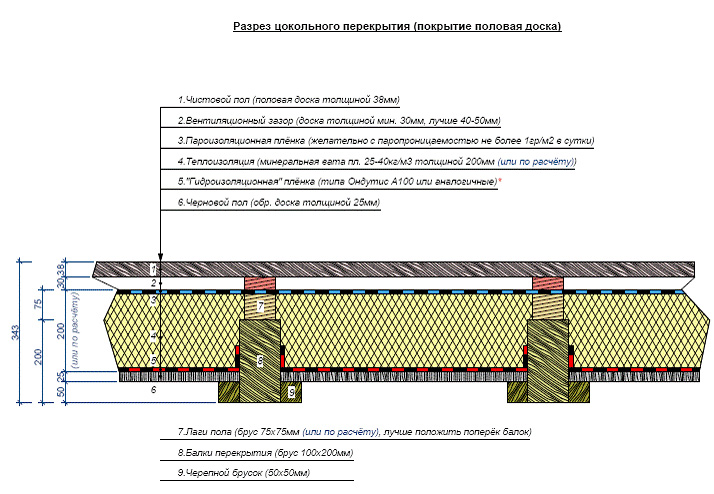
Subfloor lags
After removing the floor covering, you must immediately check the condition of the old logs. If there are defects or damage in the form of decay and cracks, as well as noticeable vibration during the application of force, such components must be replaced immediately. In this case, the work is almost the same as that carried out on the roof. The big disadvantage of the replacement lies in its duration, because all the logs are filled with concrete, so when dismantling them you will have to cut them out of the base - it will take at least one day.
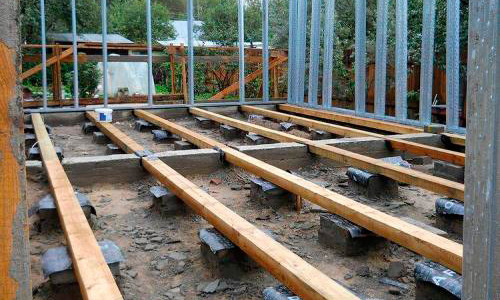
Installation of load-bearing lags
Then follows the installation of a new lag, the section of which should be similar to that of the old ones. A stretched line is used to check the horizontal level. Initially, all new logs must be carefully treated with an antiseptic compound, and their seats must also be covered with a tar paper wrap or resin.

Antiseptic treatment is required
This is followed by another level check, after which the logs are filled with cement mortar with preliminary fastening of their ends in the mounting nests by means of gravel (dry). After this, work is stopped to allow the concrete to harden.
Installation of rough cover
When choosing rough boards, you need to monitor their parameters - it is unacceptable to use boards with a thickness of less than 20 mm. As for the width, it can reach 20 cm. It is also impossible to carry out installation directly on the supporting beams - before that, it is necessary to fix the crate on them, which consists of small beams with a section of 50x50 mm and is mounted in parallel.
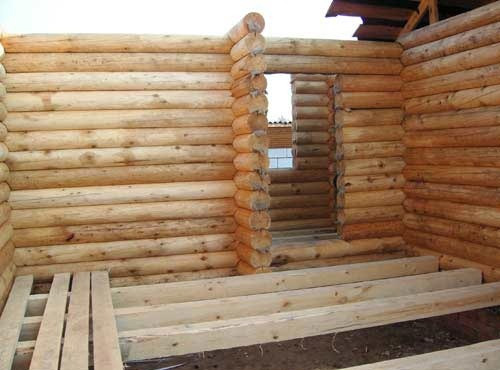
Installation of rough boards
At the end of the creation of the crate, you can start packing the boards. For this, simple nails (5-6 cm long) are used, but in such a way that they do not "go" directly into the thickness of the lag.
As for the need for antiseptic treatment of all elements wooden structure, then there are different opinions on this score. However, it is better to play it safe, purchase quality products (Finesta, Senezh, Pinotex, etc.) and spend time processing. But there will be less reason to worry about mold and possible rotting. In addition, when installing the subfloor, it is important to keep track of the same thickness of the boards - there should be no drops. With regard to possible slots - those up to 10 mm are allowed.
Waterproofing layer
For this, experts recommend using exclusively a membrane! Only under the condition of this type of waterproofing (film), a free path of moisture downward is guaranteed. In addition, it blocks its rise up. Otherwise, condensation will start to accumulate and completely new floorboards will rot in 3-5 years.

Waterproofing membrane
Installation of the membrane takes place directly on the subfloor with the grip of the walls at a height not less than the level of the final floor In addition, it is required to make smells on the layers of the film itself - like min 10 cm, after which all joints are qualitatively glued with moisture-resistant tape.
Installation lag
After laying the rough covering, it is the turn of fixing the lag. For this, bars with a section of 150x50 mm are used. They are laid in increments of 100 cm, in addition, installation takes place exclusively using the building level. A section of 75x150 mm is allowed - this is relevant in cases where the room is intended for the installation of heavy furniture.

The width between the lags - the size of the insulation
It is also possible to fix thicker lags, for which large self-tapping screws are used, which should go deep into the lower bars. For such work, they use powerful screwdrivers, and marks are left on the rough floorboards using a pencil or marker. A small gap is required between the finishing logs and the wall - it will need to be filled with insulation.
Installation of insulation and finished floor
Thermal insulation material (polystyrene foam, polystyrene, mineral wool, etc.) is placed directly on the waterproofing membrane. A combination is allowed different types insulation. It does not require separate fasteners, and the material itself should not stick out. In addition, it is necessary to ensure that there is a gap of approximately 3 cm between the insulation mats and the finished floor covering - this will provide the necessary ventilation and also prevent the accumulation of condensation. After laying the insulation, another layer of the vapor barrier is mounted on it.
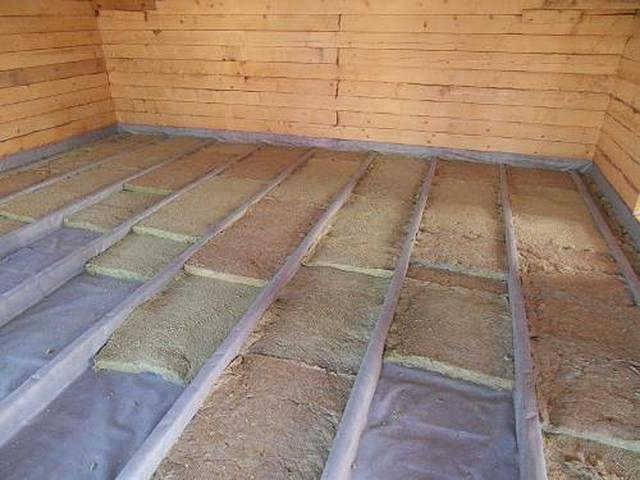
Laying insulation on a waterproofing membrane
The most effective heat insulator is izolon - foil-clad material. During its installation, the joints between the sheets are glued with the same foil tape, which will significantly reduce heat loss.

Installation of the upper layer of vapor barrier
Both new and old boards can be used as flooring (finishing). Naturally, provided they good quality... Of the fasteners, the choice of nails or screws will be optimal.

Finish plank covering
As for the options for the final coating, their mass:
- floorboards (grooved, studded or milled);
- laminate.
Outcome
As you can see, even independently insulating the floor in a wooden house is not difficult. The main thing is to deal with the materials. The topic will be discussed in the next article.
Often you have to decide how to insulate wooden floors, because they are found in almost all private houses. Lightweight wooden beams (logs) do not require increased wall and foundation strength, they are not expensive, they are simply installed.
Beams are sheathed from above and (or) from below, often with boards, forming the floor and ceiling. The principles of insulation of all wooden floors are similar to each other, let's take a closer look at these technologies.
Choose insulation for a wooden floor
For a tree to serve for a long time, it must breathe, i.e. do not come into contact with materials that restrict air movement. Or at least a large surface area of \u200b\u200bthe tree should not be insulated.Otherwise wooden parts can quickly resist, rot due to a violation of steam exchange. For this reason alone, mineral wool or other vapor-transparent materials are mainly chosen for insulating wooden floors.
It is also important to take into account fire safety when choosing a heater. A wooden floor cannot be considered an obstacle to fire, it does not fully isolate what is behind it from the living space. Therefore, it is not recommended to use materials hazardous by fire standards on wooden floors.
Again, the choice falls on non-combustible materials - mineral wool, expanded clay, vermiculite.
Styrofoam emits poison when melted or burned. Indoors, they should be located behind a plaster with a thickness of 3 cm or more, which resists flame for at least 30 minutes. And also should not come into contact with hot pipes, electrical wiring.
Insulation thickness
When choosing the thickness of insulation for the overlap, it is best to use the recommendations of SNiP. Then the insulation will be economically feasible. It is simply not profitable to apply a thin layer of insulation.Based on the recommended resistance to heat transfer of the floor, it is not difficult to calculate the approximate thickness of the insulation (the heat transfer resistance is divided by the coefficient of thermal conductivity of the material). In this case, the resistance to heat transfer directly to the floor is ignored as insignificant.
So, for the Moscow region, to insulate the attic floors of houses, at least 20 cm of mineral wool thickness is required. And for floor insulation - at least 16 cm of mineral wool.

Floor structure
Consider an attic floor. Usually, the insulation is placed between the logs. But often their height is not sufficient, so you have to build a counter batten on top of the lag, and on top of it there is already some kind of flooring.The insulation must be isolated from the steam coming out of the building, since the increased humidity of the insulation will lead to water condensation. Therefore, you need to lower the humidity and get out of the dew point in the insulation. The vapor barrier is laid between the logs, always in a continuous layer, with overlapping parts and gluing the seams, with a twist on the sidewalls of the log at least 5 cm. 
The insulation is laid without gaps in the fold, a crate is made if necessary. (More often - 15 cm of logs plus 10 cm of crate, of which 20 - 22 cm for insulation in two layers and 3 - 5 cm ventilation gap.)
The mineral wool should be covered with a diffusion membrane so that the fibers do not scatter, and also so that wind pressure is not affected. The membrane is attached to the sidewalls with a stapler as well as a vapor barrier. A layer of expanded clay must be covered on top with parchment, sand, etc. but this time to prevent convection currents inside the insulation.
When laying vapor barrier, membranes, insulation, the greatest attention should be paid to eliminating all kinds of cracks, gaps, and discontinuities. Cold bridges significantly reduce the effect of insulation.
Sound insulation, what is its feature
Interfloor wooden floors, as a rule, do not need insulation, unless a temperature difference between floors is provided. But soundproofing floors is often extremely important.For sound insulation, mineral wool is used as a good sound absorber. But the design should be different. Wooden logs are a conductor of percussion sound, redirecting it to the walls, so they must be insulated.
A rough floor is made along the logs. Rigid mineral wool slabs with a density of 60 kg / m2 and a thickness of 40 mm are laid on it. A floating (not in contact with the walls) dry floor screed is made on top, usually from gypsum fiber board. The result is a soundproofing cake - an absorber between two reflectors.
Design feature wooden floor - Prevention of dispersion of hazardous mineral wool fibers throughout the residential premises during the entire period of operation. The space where it is located is necessarily sealed, including with membranes.

Features of insulation of wooden floors
The floors on the logs are insulated according to the same principle as the attic wooden floors - the insulation is located between the logs on wooden panels that are fixed from below. The only question is in the ventilation of the insulation layer.If the subfloor is well ventilated, i.e. it will freeze and the humidity does not rise there, (or for houses on piles with a grillage and an open underground), then the vapor barrier must naturally be laid from the side of the room.
A diffusion membrane from below on a lattice fence from the ventilation side. The thickness of the insulation in this case should be the same as for the attic. 
By the way, the lower ventilation of the insulation in the underground is preferable if mineral wool is used. It is known to contain formaldehyde binders, and therefore it is not possible to ventilate it indoors (from above underground). the best option constructions.
For insulation of the underground with overhead ventilation and vapor barrier from the ground, it is better to use more environmentally friendly insulation. In extreme cases, all the same foam, shielding it with a metal mesh from the bottom of the mice.
Thermal insulation of wooden floors does not contain any difficulties, since it is not necessary to fasten the insulation. But it is imperative to provide vapor barrier and ventilation of vapor-transparent heaters and prevent water condensation in them.
Wooden floor scheme. Click on the photo to enlarge.
In modern low-rise construction, for example, in the construction of wooden suburban housing, beams sheathed with timber or sheet material are used as floors between the basement, residential and attic floors. Not only the strength and thermal conductivity of structures, but also their gas and water tightness, as well as fire resistance and durability of operation depends on how competently the installation and insulation of the floors between the floors of the house on wooden beams is performed.
In general interfloor overlap is a multi-layer structure consisting of main beams and running boards or a residential floor in a house fixed on them. If we look at the ceiling from below, we will see a semblance of a ceiling reinforced with beams. For the construction of interfloor floors, it is recommended to use well-dried, but not over-dried wood. conifers, since the structure must be strong enough.
So, interfloor insulation begins after the construction of the floors themselves in a wooden house. It is very convenient to create them using cranial bars with a section of 4x4 or 5x5 cm. These bars are tightly docked with each other and mounted between the beams. When aligning the bars along the beams, focus on the lower part of the latter.
 Section of the beams at the length of the span. Click on the photo to enlarge.
Section of the beams at the length of the span. Click on the photo to enlarge.
When the overlap takes the form of a solid surface, proceed to the waterproofing flooring. For wooden house roofing felt, roofing felt or glassine are suitable. Next, the waterproofing layer is covered with insulation. Good results are shown by insulation with sawdust, slag, aggloporite, expanded clay, as well as filling the niches of the wooden floor with mineral basalt woolsuch as the "Rockwool" brand. Like the wood of the floors itself, the insulation must be completely dry.
In any home, there is a need to clean floors. So that at this time no moisture gets under the floor covering, and therefore into the insulation, the thermal insulation should be protected with another layer of waterproofing. Only after that do they start installing the finishing floor covering.
If the beams of the wooden floor are laid with a large pitch, in order to strengthen the floor, logs are used.
Warming with cotton wool
 Comparison of mineral and ecowool. Click on the photo to enlarge.
Comparison of mineral and ecowool. Click on the photo to enlarge.
Today on the market you can find a variety of thermal insulation materials in the form of rolls or sheets of cotton wool. This wool can be mineral, slag, basalt, etc. Among its attractive characteristics are the following:
- low thermal conductivity;
- excellent sound absorption;
- high level of fire safety;
- hygiene and environmental friendliness;
- resistance to mold, decay, destruction by insects and bacteria.
Today, cotton wool is used to insulate not only ceilings, but also walls, roofs and slopes in window and door openings.
Insulation of floors with slabs
Insulation of basement, residential and attic spaces very often it is carried out by means of installation in the niches of the interfloor wooden flooring of fire-resistant rotting plates. You can buy them, or you can make them yourself. You can independently determine the shape and area of \u200b\u200bsuch a slab in order to best fit it into the space between the beams. The density of such slabs reaches 500 kg / m3, that is, a slab with an area of \u200b\u200b1 square meter and a thickness of 1 cm weighs about 5 kg.
 View of the interfloor overlap prepared for insulation. Click on the photo to enlarge.
View of the interfloor overlap prepared for insulation. Click on the photo to enlarge.
Raw materials for insulation of plates
The most common types of raw materials for insulation boards - this is foam concrete, slag concrete and sawdust concrete. Here are some recipes:
- sawdust, clay, sand, cement, water in a ratio of 4: 1: 2: 0.3: 2.5;
- sawdust, lime paste, cement, water in a ratio of 1: 1.5: 0.5: 2.
All components must be mixed well until a homogeneous mixture is obtained, and then poured into previously prepared frame forms, the length, width and height of which are determined depending on the structure of the floors in the house (on the distance between the beams). Plates are kept in a shaded and protected from moisture place until the mixture is completely dry.
The last requirement - the complete absence of moisture in the slabs - is mandatory, otherwise the insulation along the interfloor beams will be ineffective. If moisture collects in the insulation already during the operation of the floors in the house, this also threatens the plates with a complete loss of thermal insulation characteristics.
Good results are also shown by the recipe with the use of roofing material. First, roofing material is spread along the beams, and a layer of sand-clay mixture is poured over it. When this composition is completely dry, it is covered with a layer of sawdust, wood shavings or slag. If in your region in winter the temperature does not drop below minus 20 ° C, then 14-16 cm of slag, 5-6 cm of sawdust, 7-8 cm of shavings are enough.



